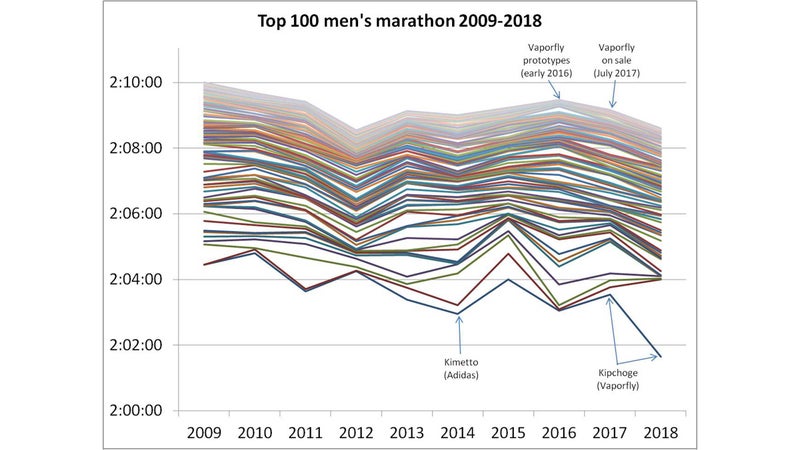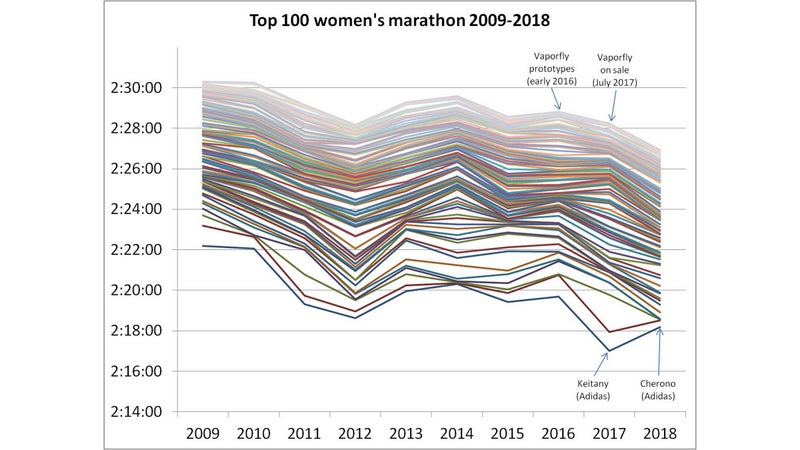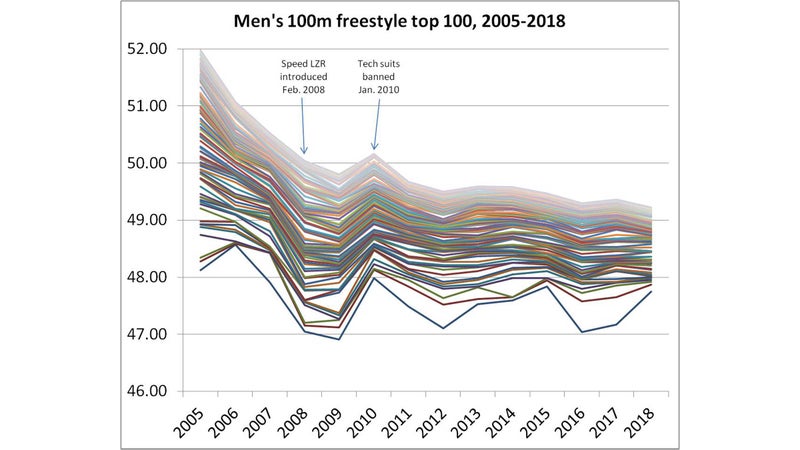For better or worse, one of the biggest questions of 2018 for running fans is: was it Eliud, or was it the shoes? Eliud Kipchoge鈥檚 insane marathon world record of 2:01:39 at the Berlin Marathon in September made him the fastest man in history by over a minute. But he was wearing Nike鈥檚 controversial Vaporfly shoes, introduced last year, which feature a thick layer of foam and a curved carbon fiber plate that reportedly make runners four percent more efficient on average. So is Kipchoge really any faster than previous record holders?
There鈥檚 no simple answer to this question. But one way to think about it is to ask what the broader trends are in marathon running. Are times getting faster overall? Even if only a fraction of elite marathoners鈥攕ay a quarter of them鈥攁re wearing new supershoes, then those runners will leapfrog past non-Nike runners and push them further down the rankings. That should produce a ripple effect that makes the 10th or 50th or 100th fastest marathoner of the year faster than in previous years, regardless of what shoe he or she is wearing.
So, with that in mind, I鈥檝e plotted the top 100 marathon times for men and women each year for the past ten years, drawing on data from the IAAF and including only the fastest time for each runner. Bear in mind that 2018 isn鈥檛 over yet, so it鈥檚 still theoretically possible that a few new performances might squeeze into the top 100 (the data is as of Dec. 10).
Here鈥檚 the men鈥檚 data:

And here鈥檚 the women鈥檚 data:

Does the appearance of the first Vaporfly prototypes in early 2016, or their general release in July 2017, bend the curve? Admittedly, these plots are basically glorified Rorschach tests: you (and I) can see whatever you want in them. But there are a few things worth noting.
Looking at the broad patterns (as opposed to the big jumps in the top few individuals), there鈥檚 no doubt that 2018 is faster than 2017, which in turn was faster than 2016. But the improvements aren鈥檛 noticeably bigger than the fluctuations in annual performance in previous years.
In fact, the most obvious feature that鈥檚 present in both men鈥檚 and women鈥檚 data is a steady improvement leading up to a peak year in 2012, followed by a few years of declining performances. Then things start getting better again sometime between 2014 and 2016 (depending on where you look), leading up to the current streak of improvement. What happened in 2012? I鈥檓 not sure. I asked a few running-expert friends, and they couldn鈥檛 reach any consensus. It鈥檚 true that 2012 was an Olympic year, which generally brings out the best in people. But the same bump doesn鈥檛 show up in 2016. My leading theory, I鈥檓 very sorry to say, is that 2012 was when the under the IAAF鈥檚 new biological passport began showing up. Perhaps that led to a subsequent chill in performances鈥攁t least temporarily.
Is the general improvement in performance in 2018 enough to raise a red flag? For comparison鈥檚 sake, I鈥檝e plotted similar top-100 data for a swimming event (I picked the men鈥檚 100 freestyle). Swimming鈥檚 results were famously skewed by the introduction of ultra-fast textile suits like Speedo鈥檚 LZR in early 2008; those suits were banned from 2010 onward. Here鈥檚 what that data looks like, drawing from the FINA鈥檚 official rankings:

The thing I should highlight is that I鈥檓 not confident in the completeness of the rankings from the earliest years. FINA鈥檚 website showcases rankings from 2008 onward, but the earlier data is available in archived form. So some of the apparent improvement between 2005 and 2008, particularly outside the very top performances, may simply be a result of more complete data. That said, the LZR swimsuit didn鈥檛 emerge out of nowhere: there was steady improvement in swimsuit technology leading up to the big dip in 2008 and 2009.
What鈥檚 unambiguous is that the introduction of new swimsuit rules in 2010 led to a slowdown across the board. At the time, many commentators () wrote about the prospect of swim records that would never be broken, thanks to the distorting effects of the now-banned suits. Curiously, that鈥檚 not what happened. Overall top-100 performances are faster now than they were in 2009. Of the 20 official men鈥檚 world records, eight have been set since 2010; 16 of the 20 women鈥檚 records are post-2010. There are many possible explanations, like faster turns and hyper-optimized swimming pools. Regulating swimsuits didn鈥檛 stop the tech-aided march of swimming progress; nor did it destroy the sport.
There are some key differences between swimming and running, most notably in the greater role of drag underwater, and the consequent importance of subtle changes in technique. Swimming鈥檚 records have always fallen more frequently than running鈥檚 records. But there鈥檚 one point that stands out to me in the graph of swim rankings. In 2008 and 2009, everyone seemed to get faster. The top swimmers were no further ahead of their competitors than they were before or after.
In contrast, take another look at where Kipchoge鈥檚 new world record sits in the marathon graph. He鈥檚 way out of sight relative to his competitors. Lots of top runners are wearing the Vaporfly. In 2017, these runners took at the six World Marathon Majors. But none of them are anywhere near Kipchoge. So it can鈥檛 all be the shoe.
The marathon, of course, is uniquely challenging. Kipchoge鈥檚 record run was his fifth official marathon in the Vaporfly, but the first when fitness, course, and weather conditions combined to give him the opportunity to shatter the record. Maybe there are other runners who will follow Kipchoge into 2:01 or at least 2:02 territory when the stars line up for them, and in doing so demonstrate that his run in Berlin wasn鈥檛 as special as it appeared. After all, by the end of 2016, prior to the Vaporfly鈥檚 release, 31 men had run 2:04:59 or better. If the Vaporfly really alters performance by several percent, we should see someone threaten Kipchoge鈥檚 record soon.
The tough question is whether we can afford to wait. If, in five years, a half-dozen men all wearing the Vaporfly have run 2:01, we鈥檒l have our answer. But by then it may be too late to convince authorities to regulate shoe technology鈥攊f it鈥檚 not already.
My new book, , with a foreword by Malcolm Gladwell, is now available. For more, join me on and , and sign up for the Sweat Science .


